If you’ve ever dreamed of snipping fresh basil for your pasta or mint leaves for your tea, you’re not alone.
Indoor herb gardens have become a favorite for anyone who wants a touch of nature at home without the need for outdoor space.
They’re simple to start, rewarding to maintain, and add a fresh, natural beauty to your kitchen or dining area. Herbs don’t just enhance your cooking — they bring life into your space.
The fragrance of rosemary or basil can instantly change the atmosphere of a room, while the sight of healthy green leaves adds warmth and charm to your home décor.
Even better, you can grow them year-round, no matter the season, with just a few simple tools and a bit of daily care.
Here are 30 indoor herb garden ideas you’ll wish you tried sooner — all practical, creative, and perfect for any home setup.
1. The Classic Windowsill Herb Garden
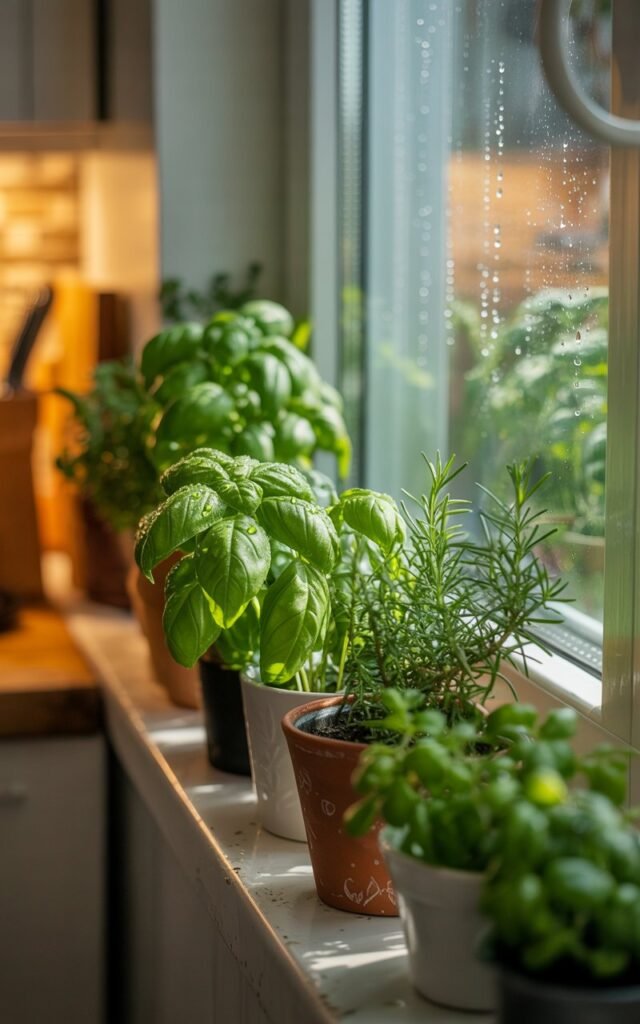
There’s something timeless about growing herbs on a kitchen windowsill. It’s where function meets simplicity — the natural sunlight, the fresh air, and the convenience of having herbs right where you cook.
This setup works especially well for those new to indoor gardening because it’s easy to manage and doesn’t require much space.
To get started, pick a window that gets at least five to six hours of sunlight each day. Choose herbs that thrive in direct light like basil, thyme, or rosemary.
Plant them in small pots with drainage holes so excess water can escape, and place a saucer underneath to protect your sill from moisture.
What You’ll Need:
Small terracotta or ceramic pots, high-quality potting soil, saucers or trays, and herb seeds or starter plants.
How To:
Fill each pot with potting soil and plant the seeds according to their depth requirements (usually written on the packet).
Water them lightly and place them on your windowsill, making sure they get plenty of light. Rotate the pots every few days so your plants grow evenly toward the sun.
Pro Tip:
If you live somewhere with limited sunlight, consider using a small LED grow light for a few hours in the evening. It helps your herbs stay green and full during darker months.
2. Mason Jar Herb Planters
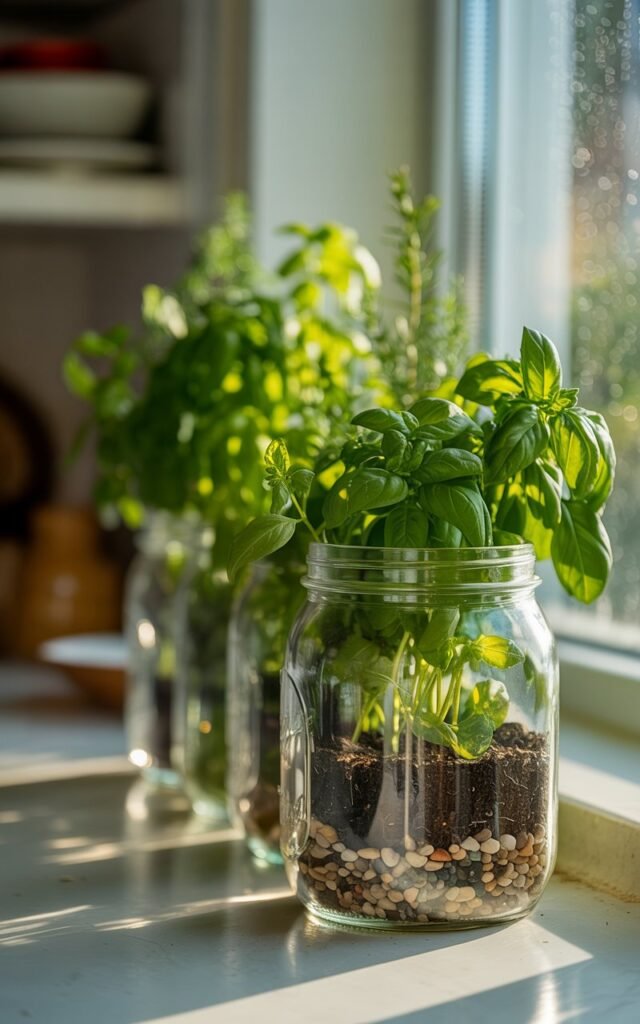
If you love rustic or farmhouse-style décor, mason jar herb planters are the perfect touch.
They look beautiful, cost very little to make, and take up minimal space. Plus, they’re great for herbs with smaller root systems like mint, parsley, and oregano.
To create your own, gather a few clean mason jars, a handful of pebbles, and some potting soil.
The pebbles are essential because they create a drainage layer, preventing the roots from sitting in water.
Even though mason jars don’t have holes, this method helps control moisture and keeps your herbs healthy.
What You’ll Need:
Mason jars (one per herb), small pebbles or stones, nutrient-rich potting soil, and herb seeds or small plants.
How To:
Place about an inch of pebbles at the bottom of each jar. Fill the rest with potting soil, leaving about an inch of space from the rim.
Plant your herb seeds, water gently, and place the jars where they can get indirect sunlight.
If your space doesn’t get much natural light, a grow light setup can help them thrive.
Pro Tip:
Wipe the inside of the jars occasionally to prevent algae growth. Also, avoid overwatering — mason jars trap moisture easily, so water only when the soil feels dry about an inch below the surface.
3. Hanging Herb Garden
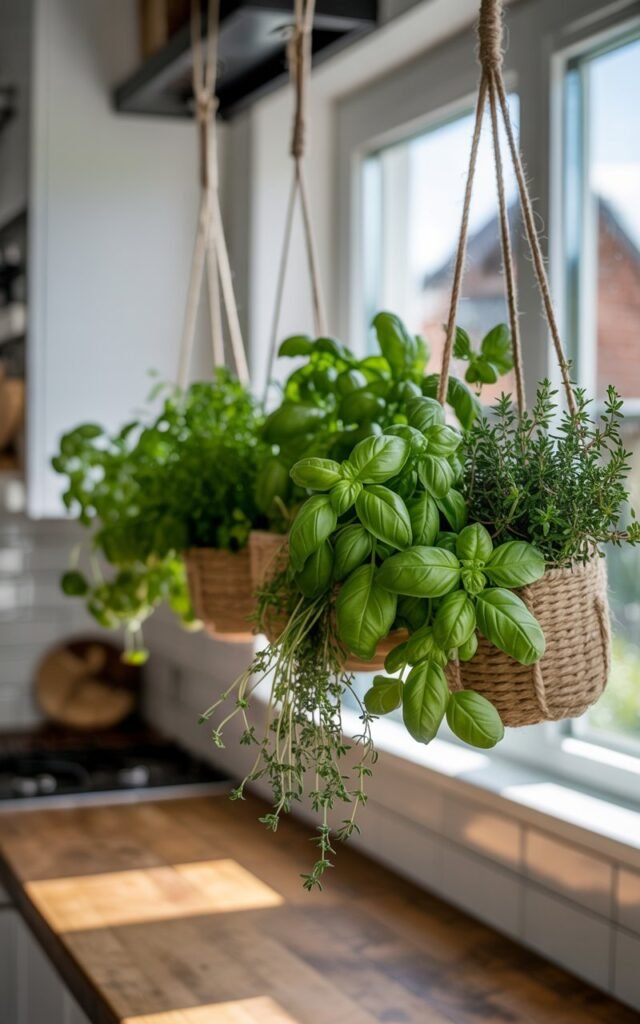
A hanging herb garden is perfect for those who want to save space or add a creative touch to their home.
Instead of cluttering your counters or windowsills, you can use vertical space to grow a wide variety of herbs.
It also turns into a beautiful decorative feature, especially when paired with natural rope hangers or modern metal racks.
You can hang small pots from a rod above your kitchen sink, use wall-mounted planters, or install a vertical garden system that fits your available space.
This setup not only saves space but also allows for excellent airflow — which helps prevent mold and mildew on your herbs.
What You’ll Need:
Hanging planters or macramé holders, lightweight potting mix, a few small herb plants (basil, oregano, parsley, and sage work best), and hooks or rods for hanging.
How To:
Fill each pot with soil and plant your herbs. Hang them in a bright area that receives at least six hours of sunlight daily — ideally near a kitchen window or balcony door.
Make sure the planters have proper drainage and hang securely. Water each plant carefully so excess moisture doesn’t drip onto your floors.
Pro Tip:
If you’re growing herbs with different water needs, group similar ones together. For example, basil and parsley like more moisture, while rosemary and thyme prefer drier soil.
Keeping them in compatible clusters makes watering simpler and reduces the chance of over- or under-watering.
4. Tiered Shelf Herb Garden
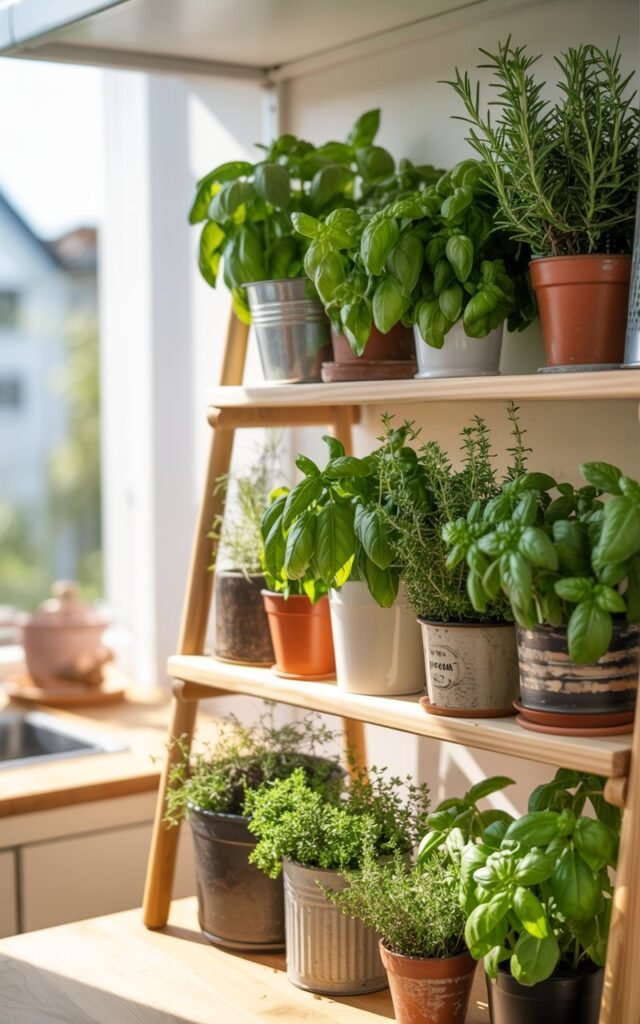
If you have limited counter space, a tiered shelf herb garden is a smart solution. It allows you to grow multiple herbs vertically, keeping everything organized and accessible.
This setup works well in kitchens, sunrooms, or even small balconies. Herbs like basil, cilantro, and parsley thrive in this arrangement because they get plenty of light without crowding each other.
What You’ll Need:
A multi-tier shelf or plant stand, small pots with drainage holes, quality potting soil, and herb seeds or seedlings.
How To:
Place your shelf near a window that receives ample sunlight. Arrange your herbs so taller plants don’t shade smaller ones.
Water each tier carefully, starting from the top to avoid overwatering plants below. Rotate pots occasionally to ensure all plants receive equal light.
Pro Tip:
Consider adding a small LED grow light above the shelves if natural sunlight is limited. It ensures all plants grow evenly and prevents leggy stems.
5. Kitchen Counter Herb Station

A dedicated herb station on your kitchen counter keeps everything within reach while cooking.
You can use small planters, a tray, or even a shallow box with multiple compartments to hold different herbs.
This makes meal prep more convenient and adds a green, fresh look to your kitchen.
What You’ll Need:
Small containers, potting soil, herb seeds or starter plants, and a tray to catch excess water.
How To:
Arrange your herbs on the tray, leaving enough space between plants for airflow. Water as needed, and trim the herbs regularly to encourage fuller growth.
Herbs like basil, chives, and mint grow quickly and are perfect for this type of setup.
Pro Tip:
Keep herbs you use most often near the front for easy access. Rotate the plants weekly so each receives enough light from the window or overhead kitchen lighting.
6. Repurposed Container Herb Garden
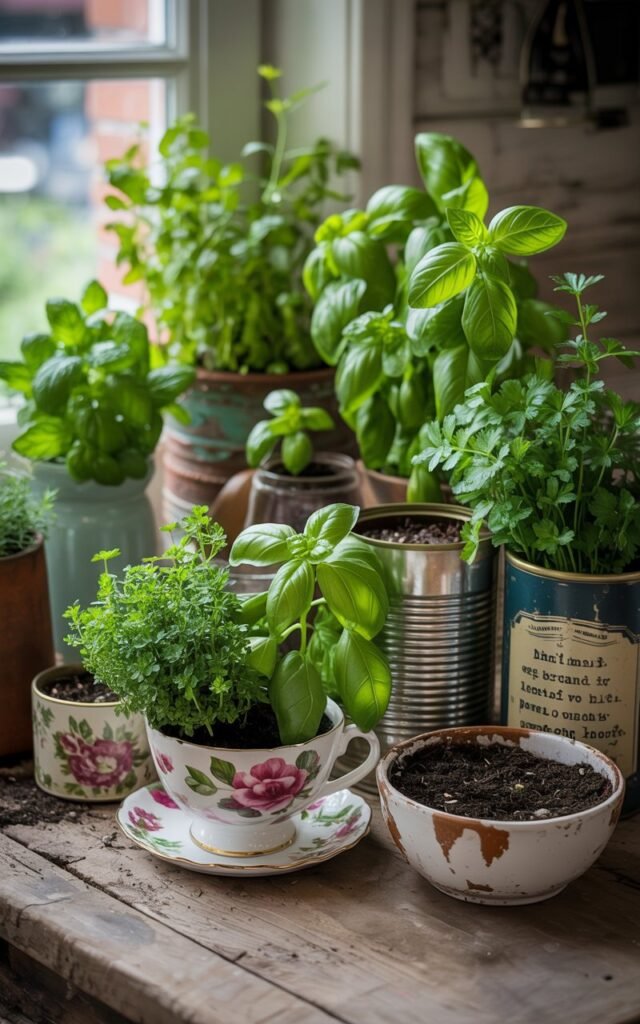
Get creative by using old tins, teacups, or even glass jars as herb planters. This method is perfect for adding personality to your indoor garden while keeping it eco-friendly.
Herbs like thyme, oregano, and mint adapt well to smaller containers as long as drainage is adequate.
What You’ll Need:
Old containers, small pebbles for drainage, potting soil, and herb seeds or seedlings.
How To:
Add a layer of pebbles at the bottom of each container, fill with soil, and plant your herbs. Arrange them on a sunny countertop, shelf, or windowsill.
Be careful with watering — smaller containers dry out faster, so check the soil daily.
Pro Tip:
Line containers without drainage with a small piece of mesh to prevent soil from escaping while still allowing water to drain. This helps maintain healthy roots and avoids waterlogging.
7. Hanging Mason Jar Garden
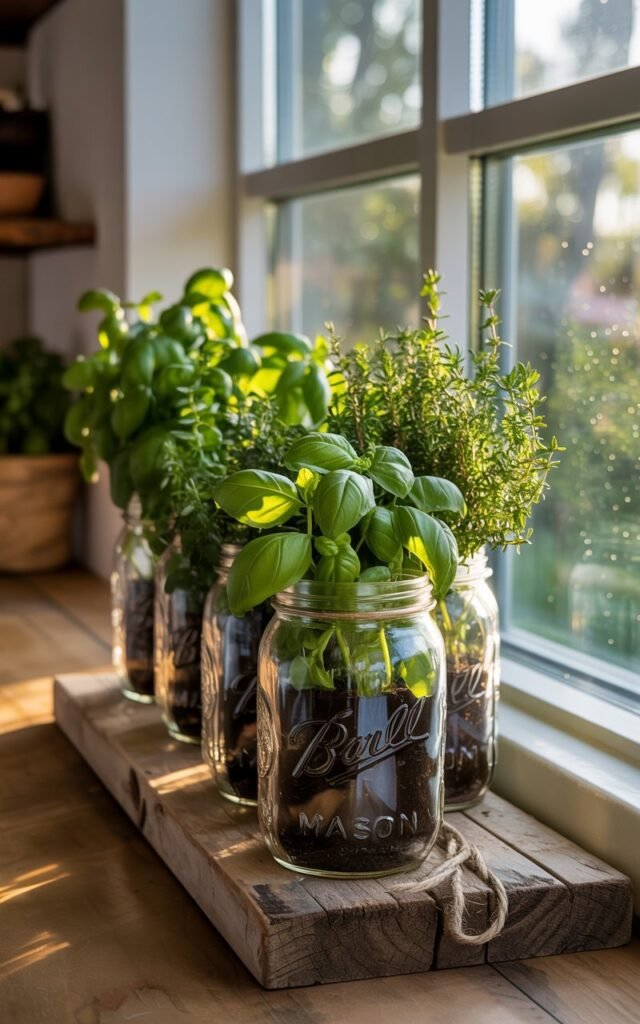
Take your mason jar planters a step further by hanging them from hooks or a suspended wooden frame.
This adds vertical interest to your space and keeps herbs out of the way of counters while still being accessible. Herbs like basil, parsley, and chives do well in hanging jars.
What You’ll Need:
Mason jars, sturdy rope or chains, hooks for hanging, potting soil, and small herb plants or seeds.
How To:
Securely hang your jars near a window. Add pebbles for drainage, fill with soil, and plant your herbs.
Rotate jars occasionally to ensure all sides receive sunlight, and water gently to avoid spilling.
Pro Tip:
Group herbs with similar light and water requirements together. This makes maintenance easier and ensures each plant thrives in its environment.
8. Mini Hydroponic Herb Garden
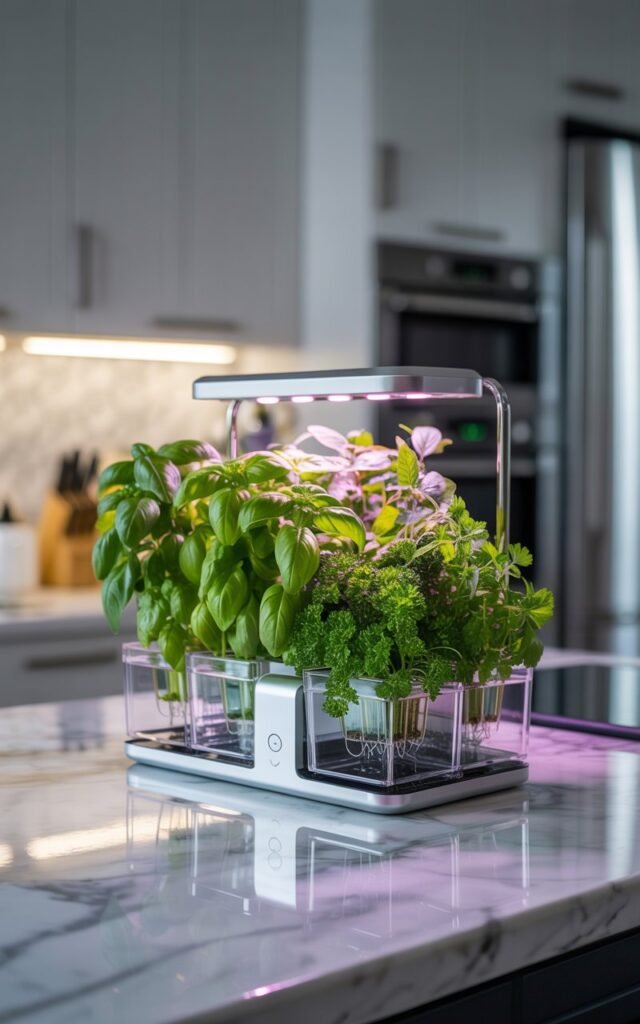
For a modern, low-maintenance approach, a small indoor hydroponic system is a great option.
These setups use water and nutrient solutions instead of soil, allowing herbs to grow quickly and cleanly. This is ideal for kitchens or apartments where space is limited.
What You’ll Need:
A mini hydroponic kit or container with water reservoir, nutrient solution, and herb seeds or seedlings.
How To:
Follow the kit instructions to add water and nutrients. Plant your seeds or seedlings in the provided net pots.
Place the system under natural sunlight or a grow light for 12–16 hours a day.
Monitor water levels and nutrient concentration regularly for optimal growth.
Pro Tip:
Rotate the herbs if your system doesn’t have a circulating water feature. This ensures even growth and prevents certain plants from getting too tall or leggy.
Final Thoughts
Indoor herb gardens are one of the simplest ways to bring life, flavor, and practicality into your home.
Whether you have a small apartment, a spacious kitchen, or just a sunny windowsill, there’s an herb garden setup that can work for you.
Growing your own herbs doesn’t just improve your cooking; it transforms your space, adds a sense of calm, and connects you with nature every day.
Even a few small pots can make a noticeable difference in how your home feels and smells.
The key is to start small, choose herbs that you actually use, and maintain them with consistent watering, sunlight, and occasional pruning.
Over time, your indoor herb garden will become a beautiful, functional, and rewarding part of your daily routine.
FAQ
Q1: What herbs are easiest to grow indoors?
Basil, mint, parsley, thyme, chives, and oregano are beginner-friendly and grow well in containers with moderate sunlight.
Q2: How much sunlight do indoor herbs need?
Most herbs need 5–6 hours of direct sunlight daily. If your space is darker, consider using an LED grow light to supplement.
Q3: Can I grow herbs without soil?
Yes, hydroponic systems allow herbs to grow in water and nutrients, which is a clean and space-saving alternative to traditional soil gardening.
Q4: How often should I water indoor herbs?
Watering depends on the plant and container size. A good rule is to check the soil — if it feels dry an inch below the surface, it’s time to water.
Q5: How do I prevent herbs from becoming leggy?
Rotate pots regularly for even light exposure, trim the tops of herbs to encourage bushier growth, and avoid placing them in low-light areas.

